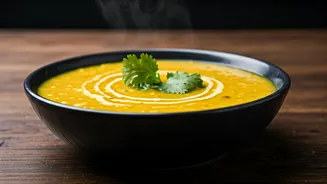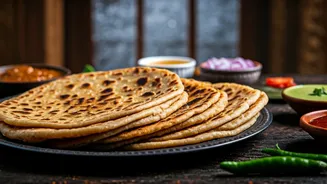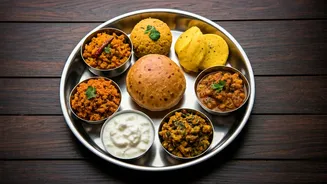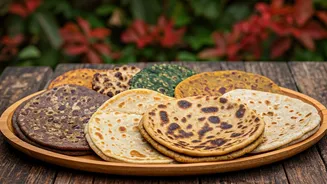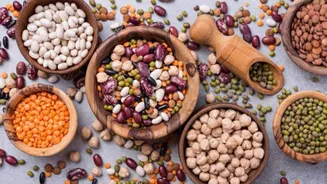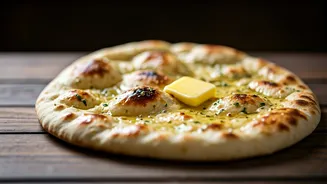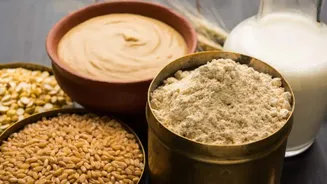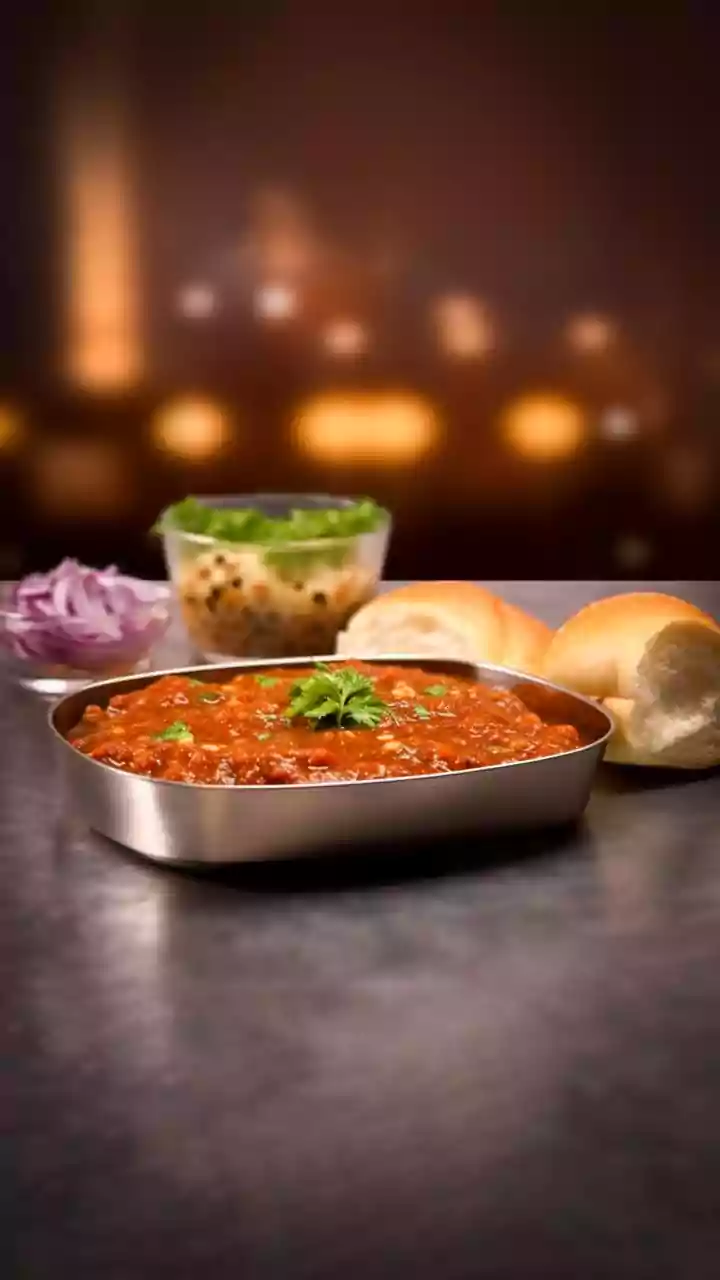Paneer Butter Masala
Paneer Butter Masala, a creamy, tomato-based curry, is a celebrated dish throughout India, particularly popular in the north. It's often associated with
celebrations and special occasions, showcasing the richness of Indian cuisine. The paneer, or Indian cheese, is cooked in a luscious sauce made from tomatoes, butter, and cream, enriched with aromatic spices. The dish's appeal lies in its balanced flavors: the slight tang of the tomatoes, the richness of the butter, and the warmth of the spices. Paneer Butter Masala is often served with naan or roti, perfect for scooping up every delicious drop. The preparation involves first creating the base of the gravy, usually by sautéing onions, ginger, and garlic, then adding tomatoes, spices, and a touch of sweetness. The paneer is added towards the end, gently simmering in the flavorful sauce to absorb its essence. The finished dish is often garnished with fresh cream and coriander leaves, enhancing its visual and flavor appeal. Each bite presents a symphony of textures and tastes, making it a favorite for both locals and visitors alike.
Biryani's Aromatic Embrace
Biryani, a flavorful rice dish, is another cornerstone of Indian cuisine, known for its fragrant layers of rice and meat (or vegetables). Its origins are traced to the Mughal Empire, where it was developed as a one-pot meal for the royal army. Biryani recipes vary widely depending on the region, with each variation offering a unique blend of spices and cooking techniques. The key to a great Biryani lies in the quality of the rice (often basmati), the marination of the meat, and the layering of flavors. There are two main types: the 'kacchi' (raw) Biryani, where the meat is marinated and cooked with the rice, and the 'pakki' (cooked) Biryani, where the meat and rice are prepared separately before being layered and slow-cooked. The slow-cooking process allows the flavors to meld beautifully, creating a harmonious blend of aromas and tastes. The dish is commonly seasoned with saffron, cardamom, and other fragrant spices, which infuse the rice with their exotic scents. Biryani is a celebration of flavors, often served with raita (yogurt dip) and a variety of side dishes, offering a complete and satisfying meal experience.
Pav Bhaji: A Street Food Classic
Pav Bhaji, a beloved street food from Mumbai, is a delightful combination of flavors and textures, consisting of a mashed vegetable curry (bhaji) served with soft bread rolls (pav). This dish emerged as a quick and affordable meal for textile mill workers. The bhaji is typically made from a mix of vegetables such as potatoes, cauliflower, peas, and tomatoes, cooked with a blend of spices. Its vibrant red color comes from the generous use of tomatoes and a specific spice mix called 'pav bhaji masala'. The dish is known for its simplicity and the way it brings together contrasting elements. The buttery, toasted pav complements the spicy and flavorful bhaji. Preparation involves mashing the cooked vegetables into a thick curry, then cooking it with butter and spices. The pav is toasted until golden brown. Finally, the bhaji is topped with a dollop of butter, chopped onions, and a squeeze of lemon. Each mouthful is a burst of flavors and textures, providing a quick and satisfying meal, perfect for street food lovers.
Khichdi: A Wholesome Delight
Khichdi is a simple yet nourishing dish, often considered the ultimate comfort food in India. Its base ingredients are rice and lentils, cooked with spices and often vegetables. This dish has been consumed for centuries, prized for its easily digestible nature and versatility. Khichdi is a great source of protein and carbohydrates, making it a wholesome and balanced meal. The variations are endless, with each household and region having its own recipe. It's often prescribed as a light meal when someone is unwell or recovering. The cooking process is straightforward: rice and lentils are cooked together with water and spices until they become soft and mushy. The seasoning can range from simple salt and turmeric to more elaborate spice blends. Khichdi can also include vegetables like carrots, peas, and green beans, which add more flavor and nutrients. This dish is usually served with ghee (clarified butter), yogurt, or pickles, providing a simple, satisfying, and comforting meal suitable for all ages.
Dal Makhani's Creamy Indulgence
Dal Makhani, a rich lentil dish, is another jewel of Punjabi cuisine, known for its creamy texture and deep, complex flavors. This dish features black lentils and kidney beans, slow-cooked in a creamy tomato sauce and butter. The dish’s origins are traced to the post-partition era, when chefs adapted their culinary practices for a new audience. The slow cooking process, often taking hours, allows the lentils to become tender and absorb the flavors of the spices and the cream, creating a rich and satisfying experience. The preparation involves soaking the lentils overnight, then cooking them with tomatoes, ginger, garlic, and spices. The slow cooking process and the addition of cream and butter at the end give this dal its signature velvety texture. The flavors mature over time, making it even more delicious the next day. Dal Makhani is usually served with naan or roti, sopping up the creamy sauce. This dish is a perfect example of how simple ingredients can transform into a dish that evokes both luxury and comfort.
Dosa: A South Indian Staple
Dosa, a popular South Indian dish, is a thin crepe made from fermented batter, typically served with sambar and chutney. This dish is a breakfast staple, loved across India for its crispy texture and versatility. Dosas are made from a batter of fermented rice and lentils, a process that gives them their unique flavor and texture. This fermentation also enhances their nutritional value. The preparation begins with soaking the rice and lentils, then grinding them into a smooth batter, followed by a fermentation process. This allows the batter to develop its characteristic sourness. The dosa is cooked on a hot griddle until it becomes golden and crispy. Dosas can be plain or filled with various ingredients, such as potatoes, onions, or paneer, making them a complete meal. Sambar, a lentil-based vegetable stew, and coconut chutney are the perfect accompaniments. Dosas are not only delicious but also a versatile option for any mealtime.
Rajma Chawal's Hearty Appeal
Rajma Chawal, a comforting combination of kidney beans (rajma) and rice (chawal), is a popular dish, especially in North India. This dish provides a satisfying and hearty meal, often enjoyed for its rich flavors and wholesome ingredients. The rajma, or kidney beans, are cooked in a thick gravy of tomatoes, onions, and spices, resulting in a slightly sweet and tangy flavor. Rajma Chawal is a staple in many Indian homes, representing both simplicity and deliciousness. The preparation involves soaking the rajma overnight, then pressure cooking them until tender. The gravy is made by sautéing onions, ginger, and garlic, then adding tomatoes and spices. The cooked rajma are added to the gravy, simmering until the flavors blend. This dish is typically served with rice, which absorbs the flavorful gravy, creating a satisfying meal. The warmth and the depth of flavor make Rajma Chawal a classic comfort food.



